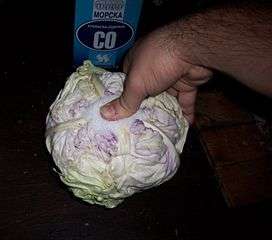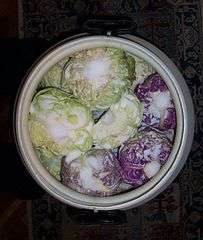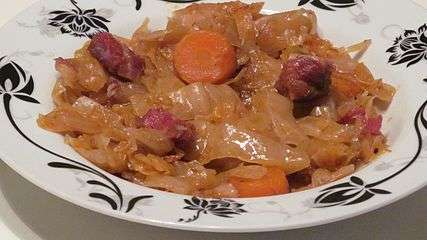Whole sour cabbage
Whole sour cabbage (Bosnian: Kiseli kupus u glavicama, literally: "cabbage soured in heads")[1] is a fermented vegetable food preserve, popular in Romanian, Bosnian, Croatian, Serbian and Bulgarian cuisines. It is similar to sauerkraut (Bosnian: Sječeni kiseli kupus, literally "chopped sour cabbage"), with the difference that it is prepared through the lacto-fermentation of whole heads of cabbage, not separate leaves or grated mass. No vinegar or boiling is required.
It is a common homemade food preserve, and many families have big barrels (10–200 liter) in their cellars or other suitable places.
Preparation
After the external leaves and core have been removed, the cabbage heads are salted, packed into the barrel as densely as possible (another reason why round form is required) and covered with salted water (4–6% of salt). A heavy load (a rock, for example) is placed above, to keep them under the water, in anaerobic conditions. From time to time the water has to be reversed (flushed from the bottom of the barrel and than again sluiced onto the top), adding somewhat (but, always with salt) if necessary.[2] A higher salinity makes the fermentation slower, while an insufficient salinity makes it unsafe. Higher temperatures require a higher salinity. The fermentation should be done at 16-22 °C. The best temperature is 18-20 °C. A cabbage fermented at a lower temperature has a better fragrance. The best known microorganisms involved in the process include Leuconostoc mesenteroides, Lactobacterium brevis, Streptococcus faecalis, Pediococcus cerevisiae and Lactobacterium plantarum.[1]
 Pressing salt into cabbage
Pressing salt into cabbage A barrel filled with cabbage heads
A barrel filled with cabbage heads
Use
Sour cabbage is popular Bosnian, Bulgarian, Croatian, Romanian and Serbian food, consumed mainly during the winter half of the year, both raw or cooked. As raw, it is a very popular winter salad, served usually dusted with pepper powder (aleva paprika) and/or black pepper (but, also just as is). In cooking it is used for sarma in the first place, and for other dishes, such as podvarak.
 Sarma
Sarma Podvarak
Podvarak
See also
References
- 1 2 Šumić, dr Zdravko; Dupalo, Predrag, eds. (10 November 2014). "Tehnologija proizvodnje kiselog kupusa". Tehnologija hrane/Enciklopedija. Tehnologija hrane. Retrieved 1 February 2015.
- ↑ Mihajlović, Ilija, ed. (7 November 2014). "KISELJENJE KUPUSA". AGRO INFO TEL. Agroinfotel. Archived from the original on 5 February 2015. Retrieved 1 February 2015.